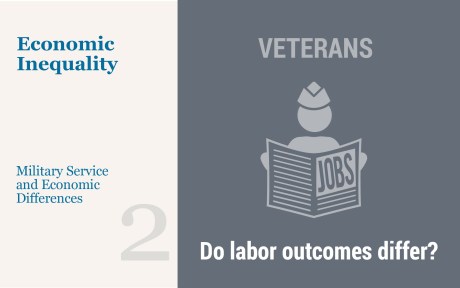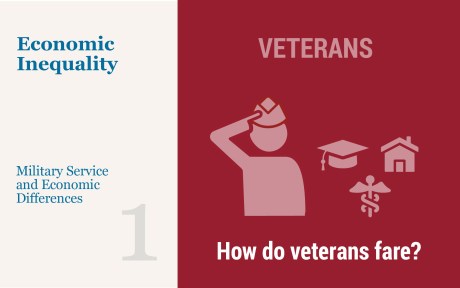
Veterans constitute a significant segment of the male labor force, and understanding labor market disparities between veterans and non‑veterans is an important component of studying disparities in the economy as a whole. In a previous Liberty Street Economics post, we have shown that even relative to a group of comparable non-veterans, veterans have lower employment and labor force participation rates. One year later, we see that veterans continue to experience lower labor market attachment and the employment gap has widened, though the earnings gap has closed.
Comparing veterans with the general population can be misleading because veterans are predominantly male, almost always have at least a high school degree and tend to come from relatively less populated parts of the U.S., among other differences. Therefore, as in our previous blog series, we construct a group of comparable non‑veterans to account for these obvious differences. Comparable nonveterans are men with at least a high school degree who are reweighted so that their distribution of age, race, ethnicity, and birthplace in the U.S. matches those of veterans. Thus, because veterans are disproportionately more likely to be native-born and older than non‑veterans are, we give additional weight to older, native-born men with at least a high school degree in the comparable non‑veterans group.
The chart below shows employment rates of veterans and comparable non‑veterans aged 25-54. Veterans have high employment rates (above 80 percent except during the pandemic recession and its aftermath) relative to the prime age population as a whole, in part because they are predominantly men with at least a high school degree, and employment rates are higher both for men and for better-educated workers. However, comparable non‑veterans have even higher employment rates, typically reaching above 85 percent. Relative to comparable non‑veterans, veterans have lower employment by about 3 to 5 percentage points on average. In a previous blog post on veterans, we showed that this employment gap can largely be explained statistically by the facts that veterans tend to have worse health and lower educational attainment than non‑veterans do, though we cannot answer whether these are consequences of military service or the result of selection into being a veteran.
Employment of veterans and comparable non‑veterans has followed similar dynamics since 2019, dropping sharply during the pandemic and then largely rebounding to pre-pandemic levels by the spring of 2022. While the veteran employment gap (difference between the employment rate of veterans and non-veterans) shrank temporarily after the pandemic recession, it subsequently reopened and is currently slightly higher than the immediate pre-pandemic difference. In April 2024, the veteran employment gap stands at 4.74 percentage points, larger than the gap (3.99) one year back, well above its minimum of 1.34 points in August 2020, and slightly larger than the 4.30 percentage point gap in February 2020 (all data are seasonally adjusted). However, the monthly employment data are volatile and we will continue to monitor the gap.
The Employment Gap for Veterans Has Reopened Since the Pandemic
Employment-to-population ratio (percent)
Note: The shaded area indicates a period designated a recession by the National Bureau of Economic Research.
Considering differences in the unemployment rate of veterans and comparable non‑veterans, we find that both groups had unemployment rates slightly below the national average in 2019 (a little over 3 percent). Unemployment rates spiked during the pandemic recession, but then declined to below their pre-pandemic levels by the summer of 2022. Since then, unemployment rates for both veterans and comparable non‑veterans have risen modestly, roughly back to their pre-pandemic levels. However, unemployment rates for both veterans and comparable non-veterans are very similar, with comparable non-veterans having slightly higher unemployment rates for much of the post-pandemic period. As of April 2024, comparable non‑veterans have an unemployment rate of 3.15 percent while veterans have an unemployment rate of 3.24 percent.
The next indicator that we consider is labor force participation. Labor force participation tends to evolve similarly to employment rates as many people tend to leave the labor force when unemployment increases. Veterans have systematically lower labor force participation than comparable non‑veterans do, the differences being largely explainable by their worse health and lower educational attainment post-high school. As with the employment rate gap, the veterans labor force participation gap shrank in the immediate aftermath of the pandemic and then rebounded back, being larger in April 2024 than it has been in either April 2023 or April 2022.
The Labor Force Participation Gap Drives the Employment Rate Gap
Labor force participation (percent)
Note: The shaded area indicates a period designated a recession by the National Bureau of Economic Research.
The final indicator we turn to are real weekly earnings. In last year’s blog series we showed that during 2015-19, veterans had lower real earnings than comparable non-veterans did (both deflated by the CPI). However, the chart below, while testifying that this trend was present in 2019, shows that real weekly earnings have essentially equalized between veterans and comparable non‑veterans. Non‑veterans were still outearning veterans in 2021, but by the spring of 2022, the gap had disappeared. Although the gap had closed up at various points before spring 2022, it now has been small for over two consecutive years. Currently, veterans earn on average $1,256 per week (in January 2019 dollars), which is $16 more than non‑veterans do.
The Veteran Real Earnings Gap Disappeared in Spring 2022
Weekly earnings (real, U.S. dollars)
Note: The shaded area indicates a period designated a recession by the National Bureau of Economic Research.
Thus, one year after our initial blog series on veterans, the main themes remain the same but the trends are showing small but noticeable changes. Gaps in employment and labor force participation between veterans and comparable non‑veterans persist, and the employment gap opened up slightly. However, there is no evidence of veterans persistently earning less than non-veterans. We will continue to monitor the state of the labor market for veterans as the economy evolves.

Rajashri Chakrabarti is the head of Equitable Growth Studies in the Federal Reserve Bank of New York’s Research and Statistics Group.

Dan Garcia is a research analyst in the Federal Reserve Bank of New York’s Research and Statistics Group.

Maxim Pinkovskiy is an economic research advisor in Equitable Growth Studies in the Federal Reserve Bank of New York’s Research and Statistics Group.
How to cite this post:
Rajashri Chakrabarti, Dan Garcia, and Maxim Pinkovskiy, “Veterans in the Labor Market: 2024 Update,” Federal Reserve Bank of New York Liberty Street Economics, May 22, 2024, https://libertystreeteconomics.newyorkfed.org/2024/05/veterans-are-doing-better-in-the-labor-market/.
Disclaimer
The views expressed in this post are those of the author(s) and do not necessarily reflect the position of the Federal Reserve Bank of New York or the Federal Reserve System. Any errors or omissions are the responsibility of the author(s).

















 RSS Feed
RSS Feed Follow Liberty Street Economics
Follow Liberty Street Economics
— Thank you very much for your interest in our work! Self-employed veterans count as employed and as participating in the labor market.
Are self employed veterans counted as participating in the Labor Market. I believe that veterans (through self employment) are the largest employer of veterans? Your thoughts please. Bill Elmore